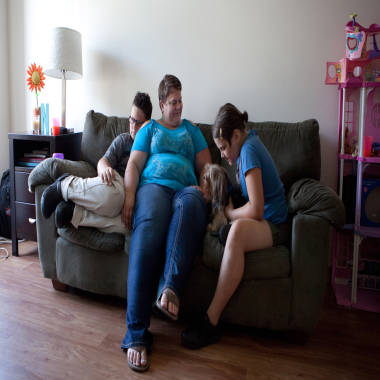In Plain Sight
Peter Dicampo / for NBC News
Nicole Oman works in the property management office of the YWCA Family Village in Issaquah, WA, where she also lives, on August 12, 2013. Photo by Peter DiCampo.
By Allison Linn, Staff Writer, NBC News
Here’s one thing both critics and supporters of the modern welfare system agree on: The direct assistance program as we knew it in the 1980s and 1990s is dead and gone.
“It’s a very different program than it was in the past. The comment about welfare queens is much less justified now,” said Ron Haskins, a key adviser of the Republicans’ welfare reform effort who now works at the Brookings Institution.
Two decades after President Bill Clinton promised to “
end welfare as we know it” -- and nearly four decades since President Ronald Reagan repeatedly derided the “
welfare queen” while on the 1976 presidential campaign trail -- far fewer families are receiving cash and voucher assistance, and a larger share of less educated single moms are working.
“People think everyone who is poor gets welfare, and it’s just not true,” said Heather Hahn, a senior research associate at the Urban Institute.
Still, experts are deeply divided on how successful tax and welfare reform efforts of the 1990s have been in improving the lives of less educated single mothers, especially in the wake of the Great Recession and weak recovery.
About 1.72 million families received direct assistance during an average month in 2012 through Temporary Assistance for Needy Families, according to
the latest data from the federal government’s Office of Family Assistance. That’s about half the 3.94 million families who received TANF in 1997, according to
an Urban Institute report funded by the U.S. Department of Health and Human Services.
In addition, about 62 percent of never-married moms ages 20 to 49 with a high school degree or less were working in 2011, according to
an analysis of Current Population Survey data prepared by the Center on Budget and Policy Priorities, a liberal-leaning think tank. That’s up from about 51 percent in 1992, but down from 76 percent in 2000, before two recessions hit low-skill workers hard.
Welfare-to-work
Welfare has not been the same since the mid-1990s, when the old program, called Aid to Families with Dependent Children, was replaced by TANF. The
new program requires that recipients do 20 to 30 hours a week of work-related activities, such as job hunting or community service, among other stipulations.
Most states also only allow adults to collect TANF for a maximum of five years over the course of their lifetime, or less.
“The expectation is that you need to be looking for work,” said LaDonna Pavetti, vice president for family income support policy at the Center on Budget and Policy Priorities. “And if you don’t, you will either have your benefits reduced or you’ll lose them entirely.”
Many more low-educated single moms did start working soon after the program was introduced, but experts say welfare-to-work cannot take all the credit for that. The late-1990s welfare reform effort also coincided with the expansion of the earned income tax credit, which provides financial assistance to low-wage workers, and a strong labor market.
“There really were three factors: One was welfare reform, one was expansion of the EITC and one was (the) economy,” Pavetti said. “Welfare reform was not the biggest role in that.”’
 |
Peter Dicampo / for NBC News
Nicole Oman at home with her son Holden, age 12, and daughter Madison, age 10, in their apartment.
|
Working, but struggling
These days, Kathryn Edin, a professor of public policy at Harvard University, said the good news is that many single mothers who used to be longer-term welfare recipients are now workers who only need assistance once in a while.
But the bad news for single moms with low education and skills is that in the past decade or so, it’s become increasingly difficult to find a stable, full-time job that pays well. That means some moms may now be working very hard, and still find that their families are at poverty or near-poverty levels.
A person working a full-time, minimum wage job would take home $15,080 a year. That’s below the U.S. Census Bureau’s 2012
poverty threshold for a family of one adult and two children under 18.
About 41 percent female-headed households with children under age 18 were living in poverty in 2011, according to the U.S. Census Bureau. That’s up from 33 percent in 2000.
Many also fret about a group of women who were not able to make it into employment at all and who may now be in deep poverty.
“What ended up happening … is a lot of families fell through the cracks,” Edin said. Her recent research has documented a
sharp increase in extreme poverty among the families with children that have been most affected by welfare reform.
Most experts say that even in a low-wage job, a single mother is better off financially than on welfare because welfare payments are so low. In July 2011, the
maximum monthly TANF payment for a family of three ranged from $170 to $923 a month, depending on the state, according to the U.S. Department of Health and Human Services.
But many concede that one optimistic hope for welfare reform – that women who entered low-wage work would gradually get better-paying jobs – has not generally materialized.
“The idea that these moms are going to go into the labor force, they’re going to get skills, they’re going to move up, they’re going to make more money … that did not happen very much,” said Haskins, who also advised President George W. Bush on welfare in 2002.
From homeless to employed
These days, the small group of adults who do end up receiving TANF are often at rock bottom.
Nicole Oman is an example. The mother of three children received $454 a month from TANF after she divorced her husband of 14 years and got into another relationship she described as unhealthy.
That was in 2011, and Oman and her children were staying in a homeless shelter where she was required to do around 30 hours of chores, training and therapy for victims of abuse.
After completing the shelter’s program, Oman used a community job search program offered through TANF to land a position with a residential YWCA facility in Issaquah, Wash., outside Seattle.
She now typically earns about $1,150 a month handling some of the YWCA Family Village at Issaquah’s tax compliance requirements. She also receives several hundred dollars a month in food stamp benefits, now known as SNAP.
Oman, 38, also was able to move into a subsidized two-bedroom apartment in the YWCA community, saving her a long bus ride from another temporary housing facility.
After spending years in homeless shelters, Oman revels in having a job and her own apartment.
“The thing that this process makes you is grateful for the craziest little things,” she said
For Oman, it’s having her own kitchen, which means she can cook meals for her family for the first time in years.
For her 10-year-old daughter, it was learning that the bus route near their new apartment would drop them right in front of a major grocery store, instead of having to walk a long way to a less desirable store.
The family’s grocery trips recently got even easier. A few weeks ago, Oman was able to buy a 2001 Ford Taurus. It’s the first time she’s been able to afford a car in nearly three years.
Oman says the job has helped her get back on her feet by giving her more than just a paycheck.
“The gals that I work with, they’ve helped me so much … in rebuilding myself,” she said.










![NEOCASTRISMO [Hacer click en la imagen]](http://4.bp.blogspot.com/_5jy0SZhMlaU/SsuPVOlq2NI/AAAAAAAAH1E/4xt2Bwd2reE/S150/ppo+saturno+jugando+con+sus+hijos.jpg)





